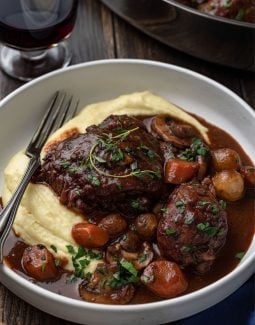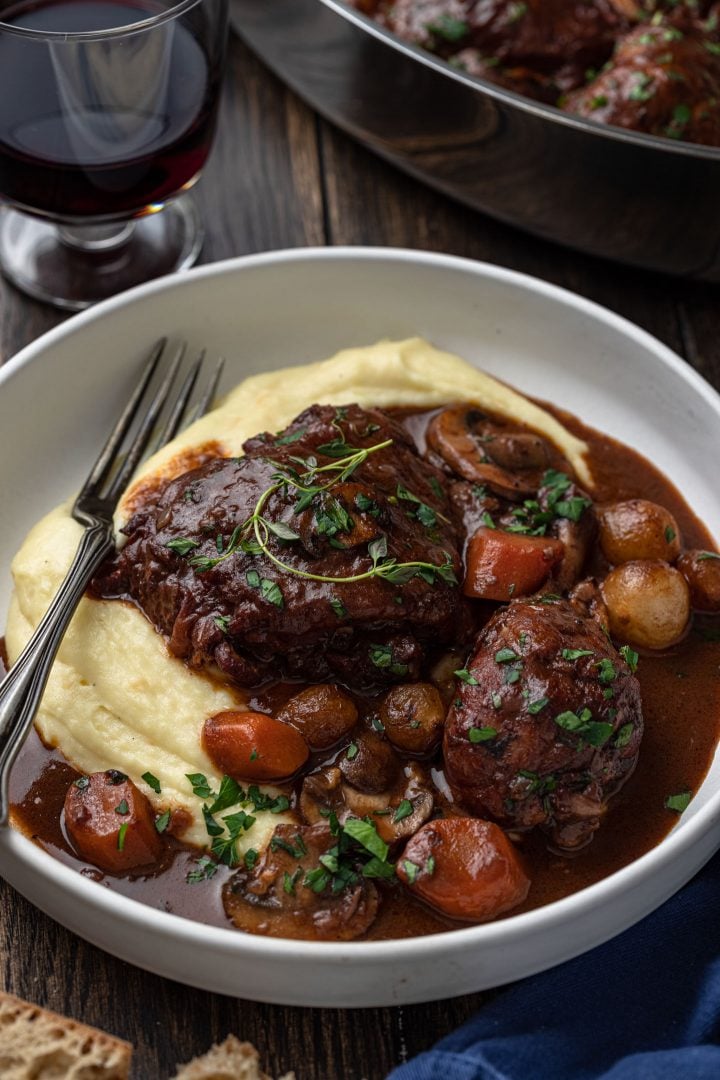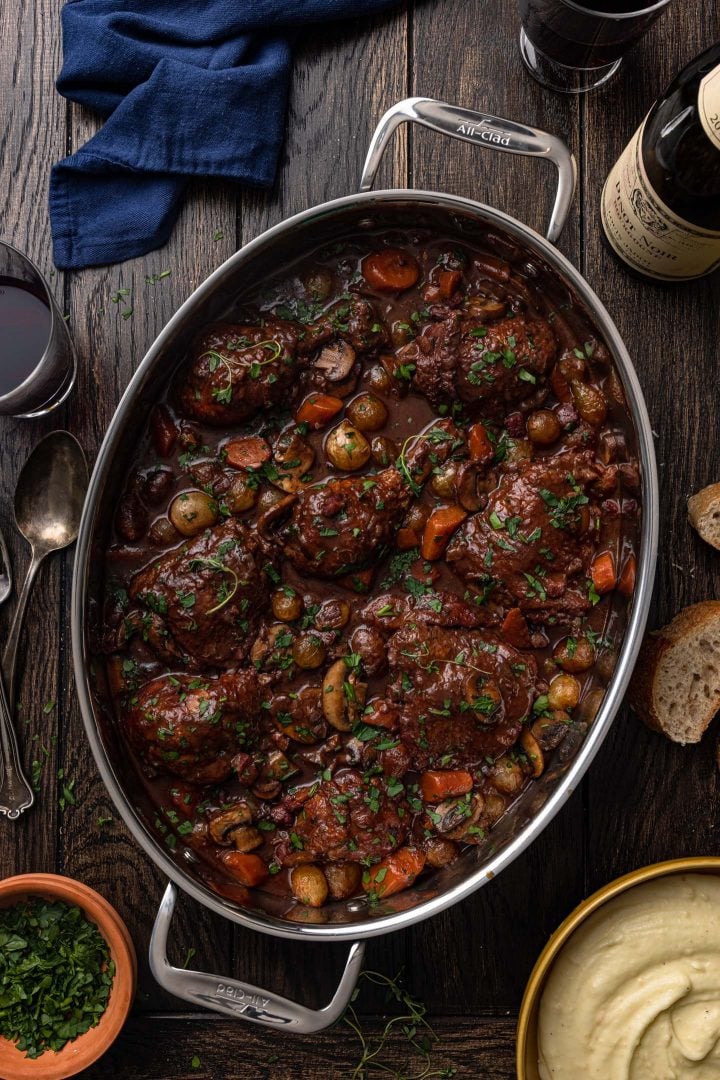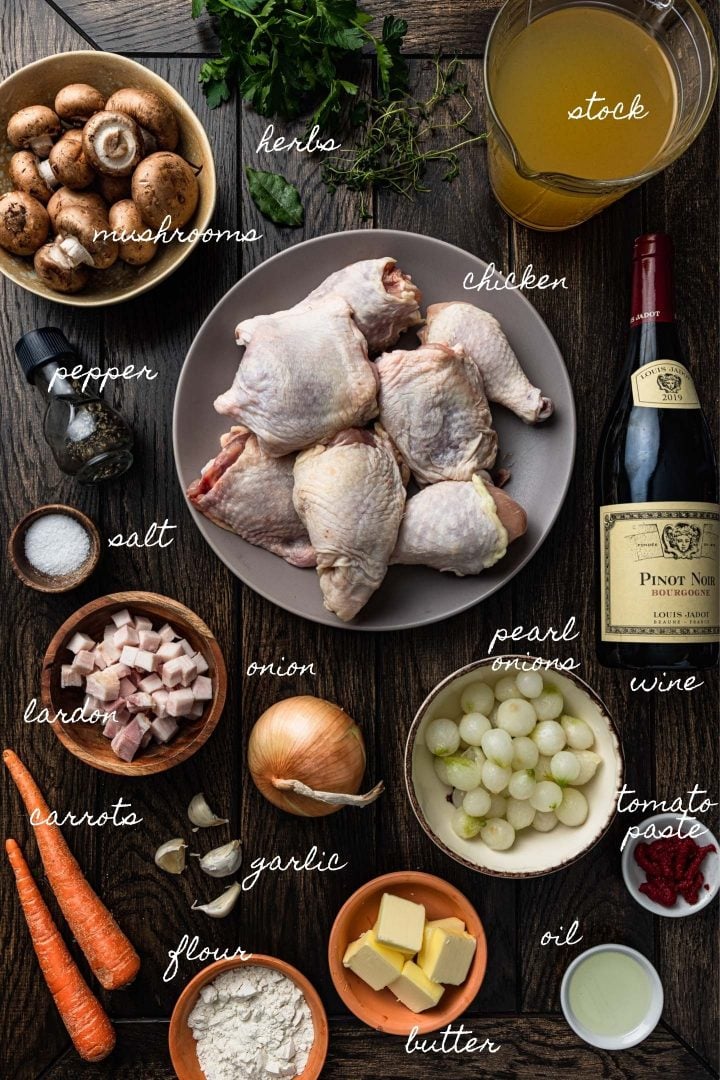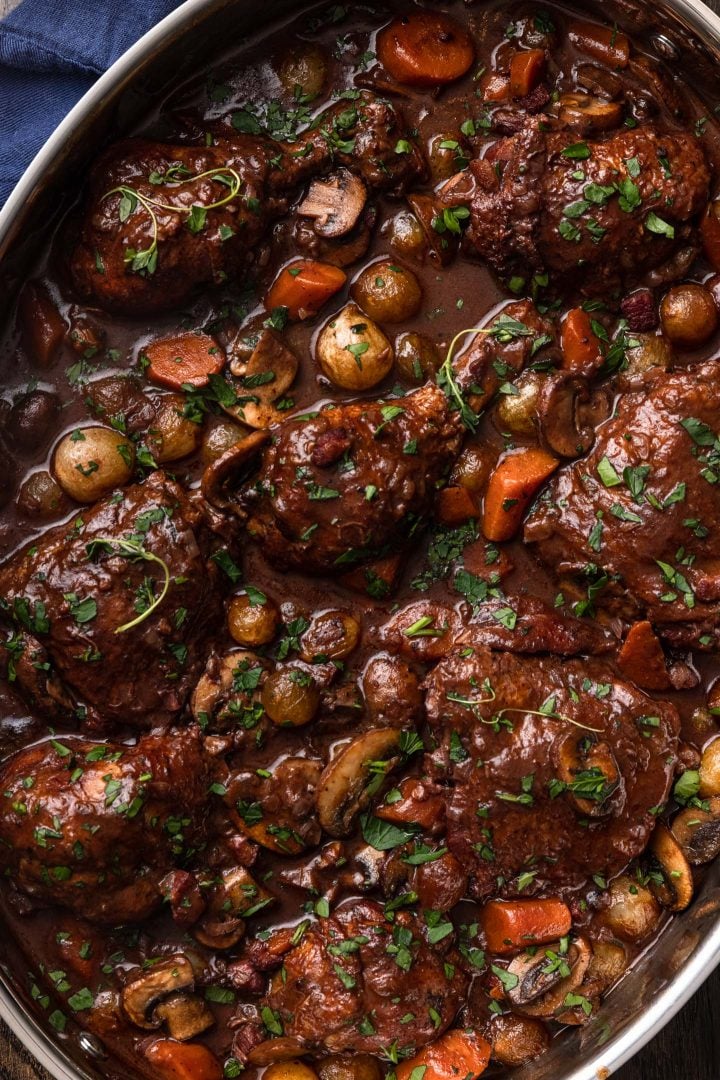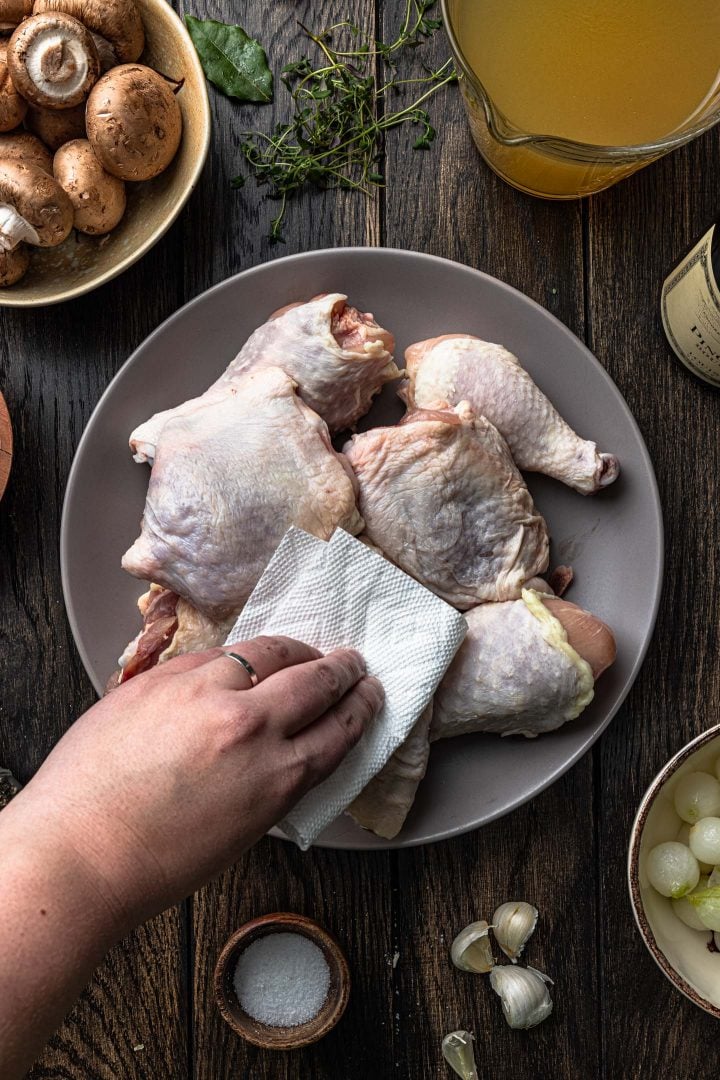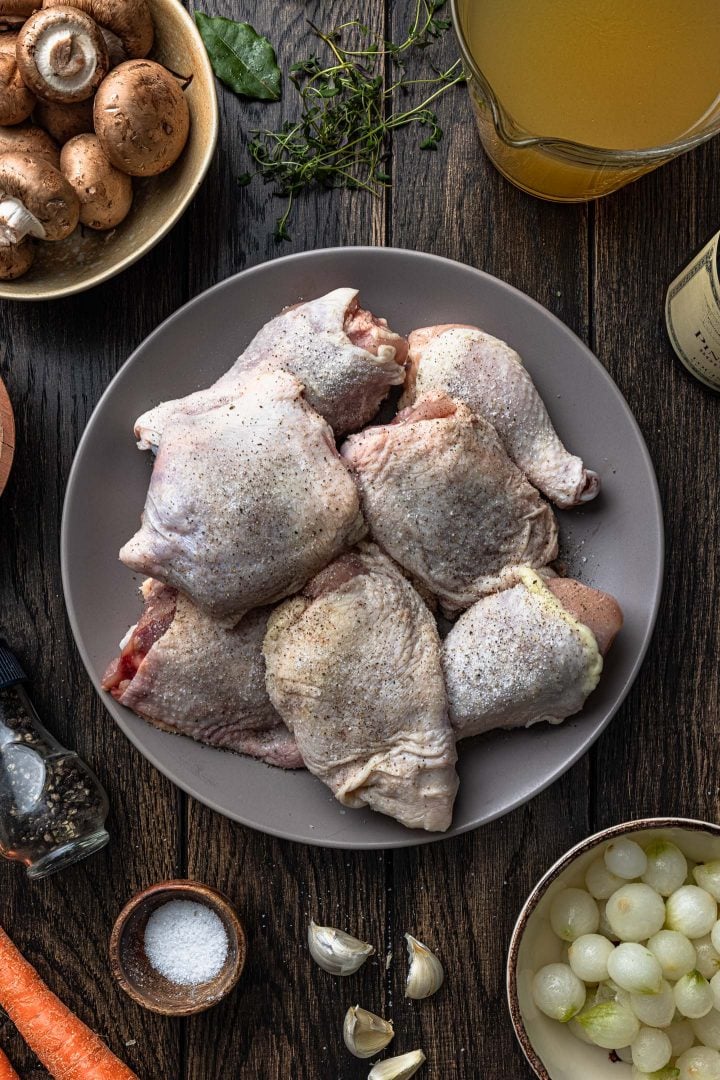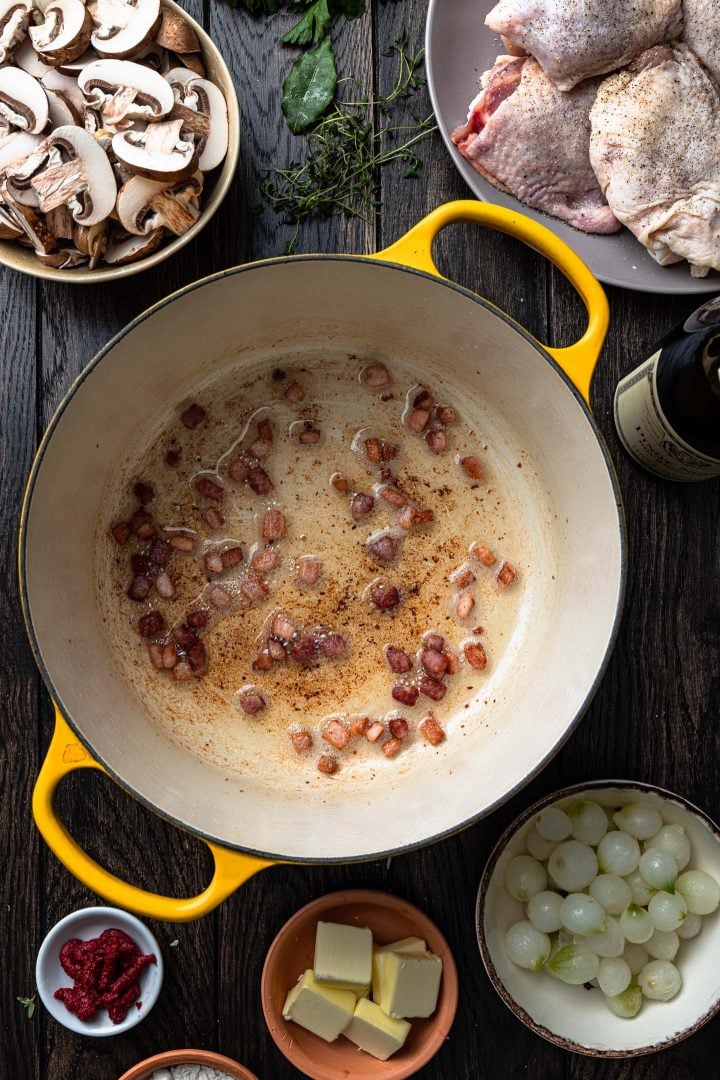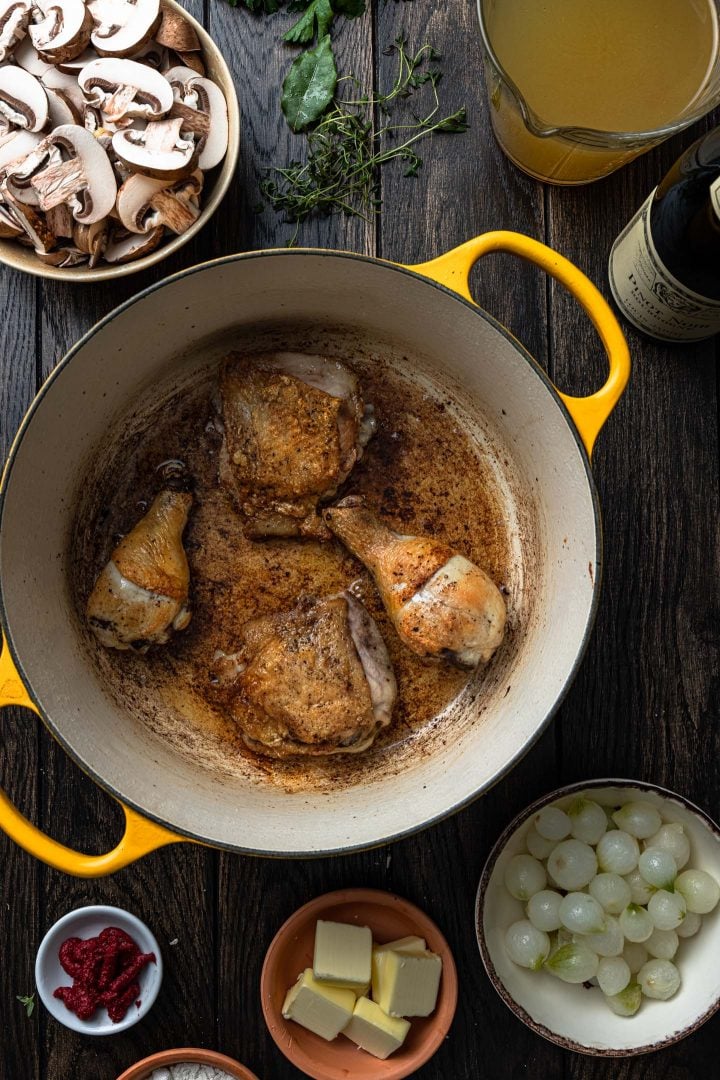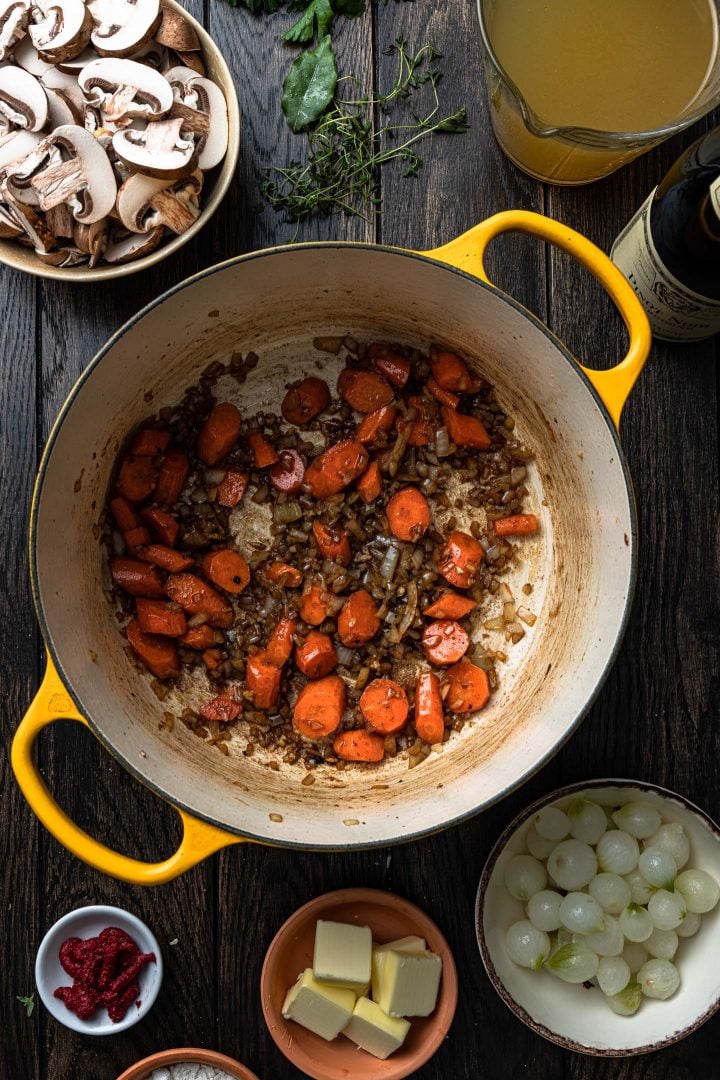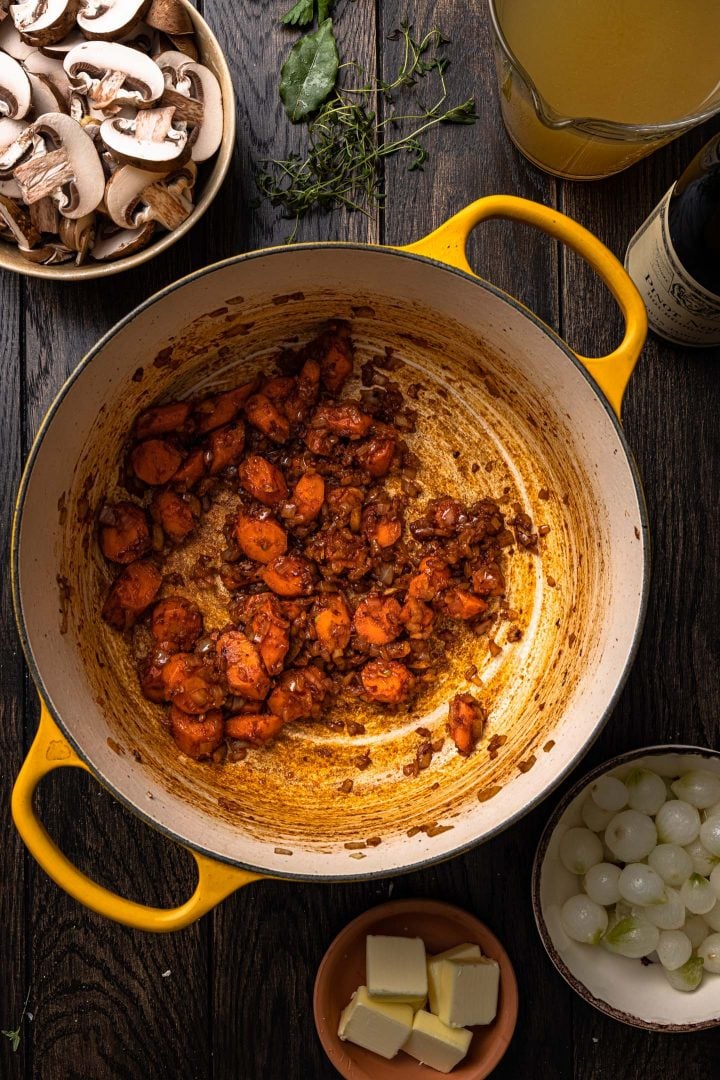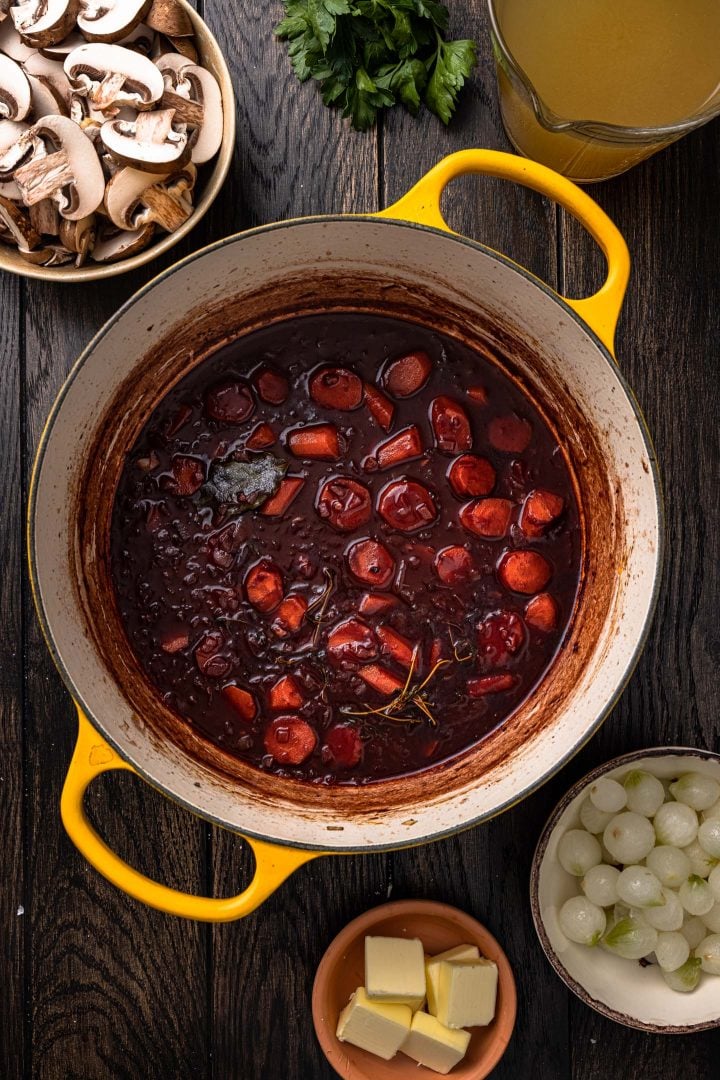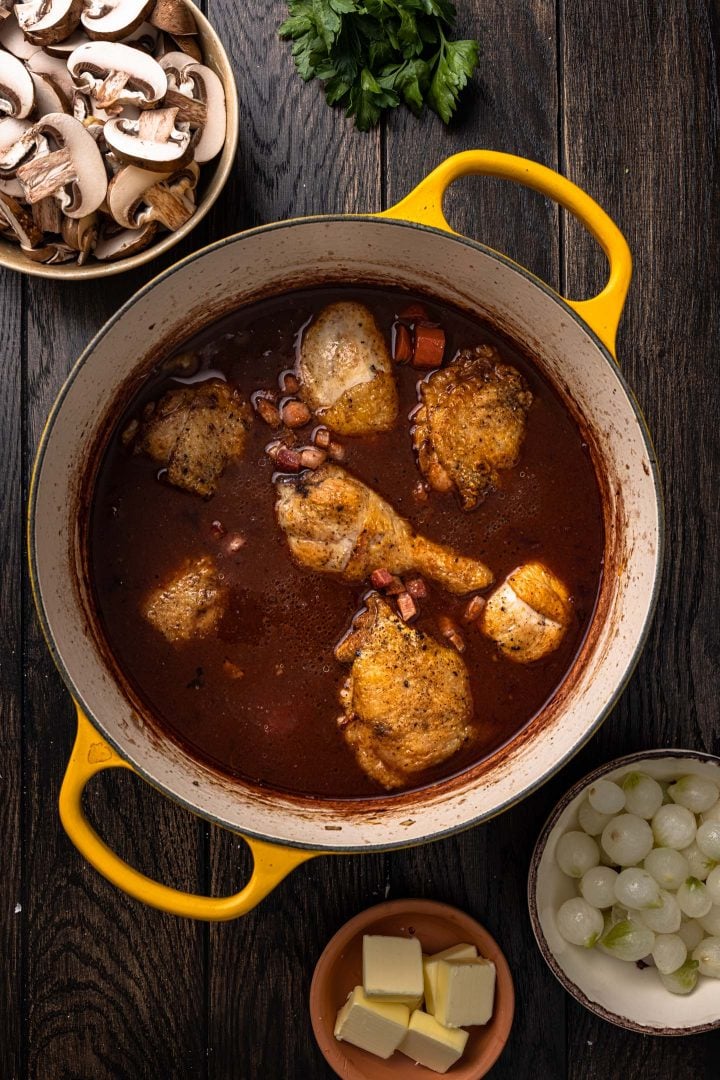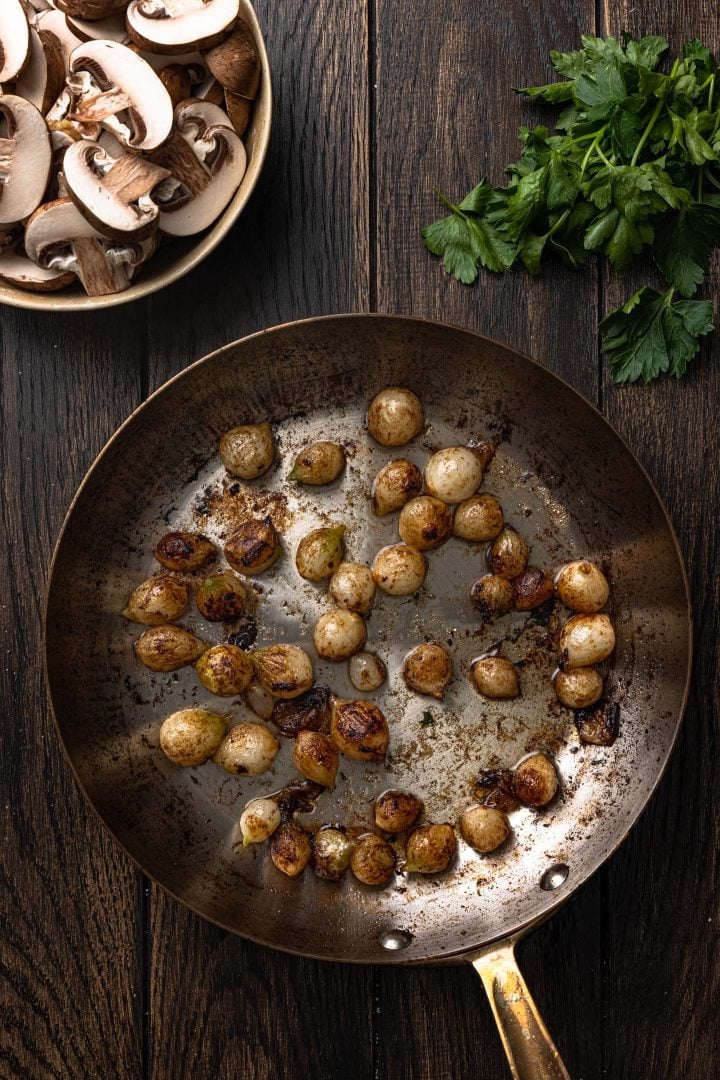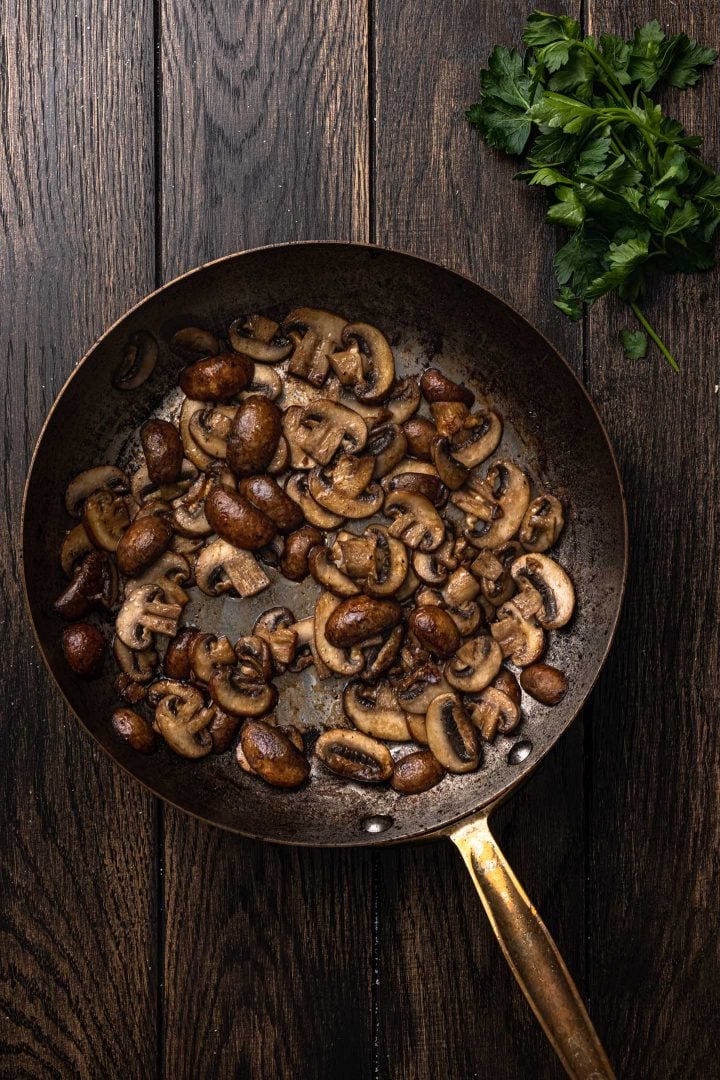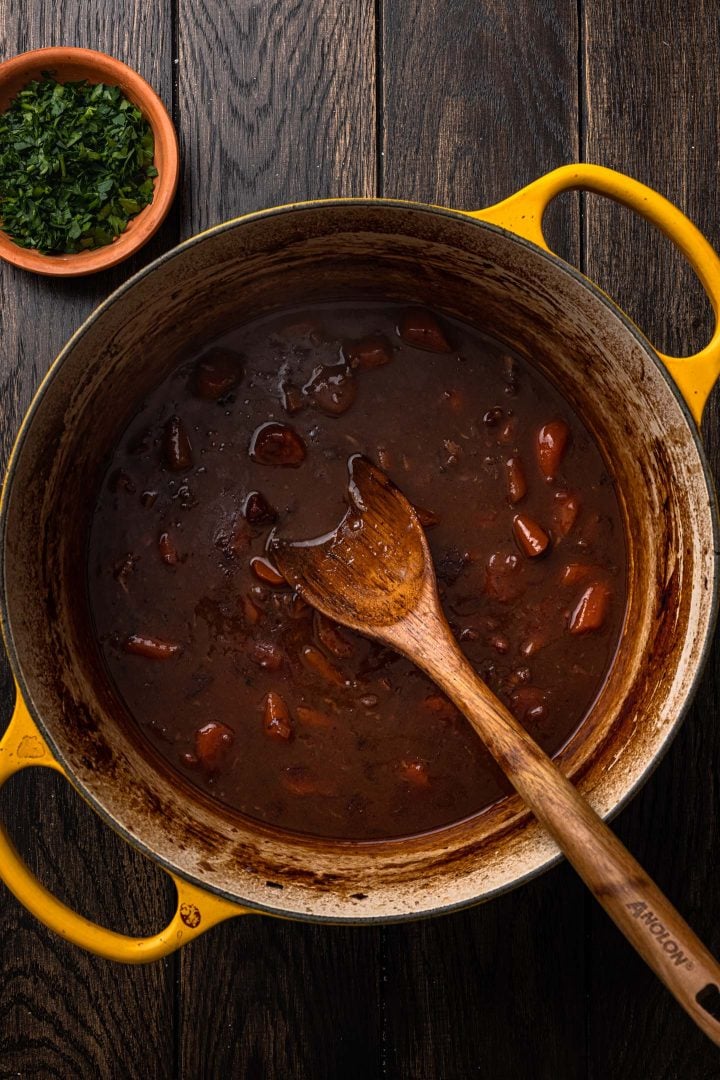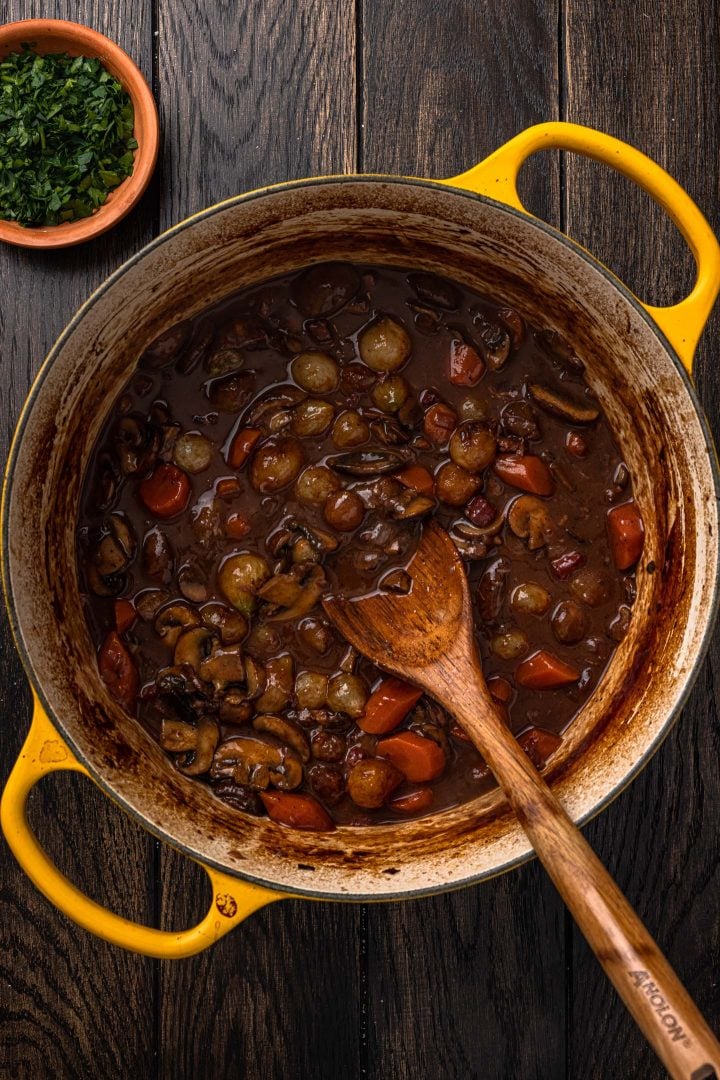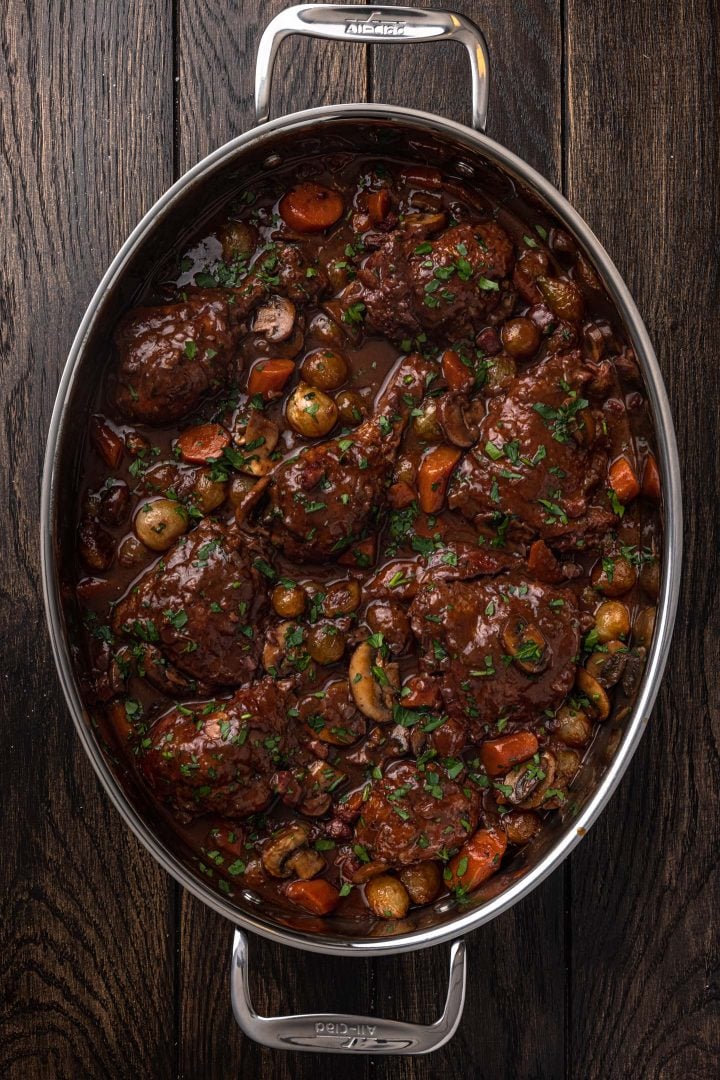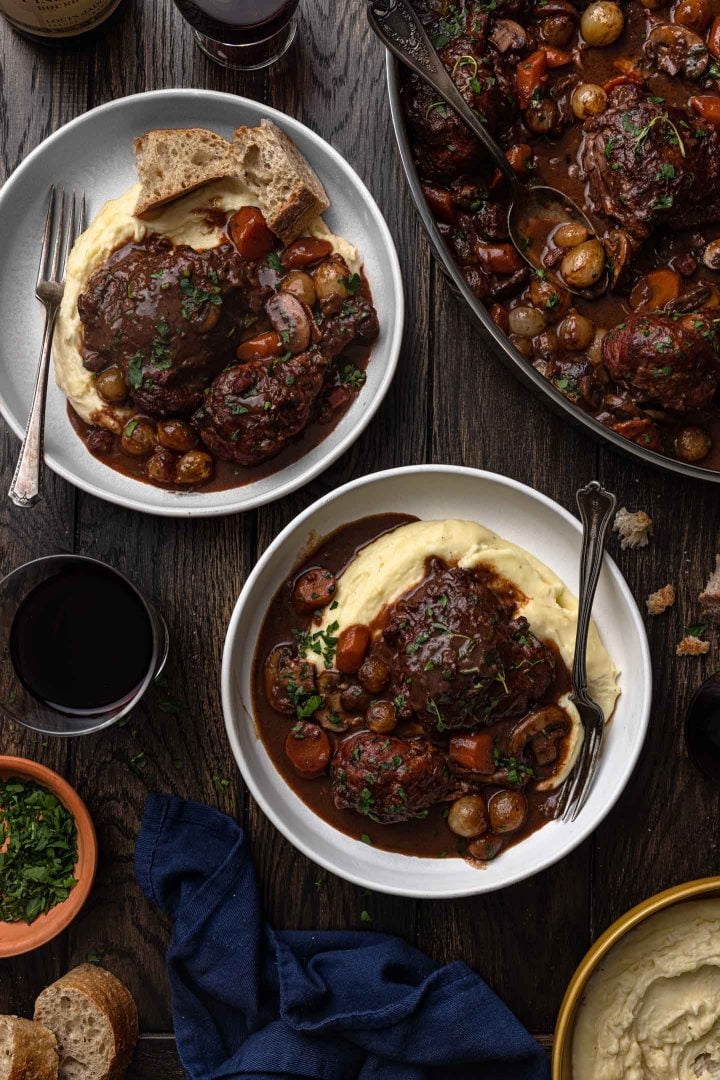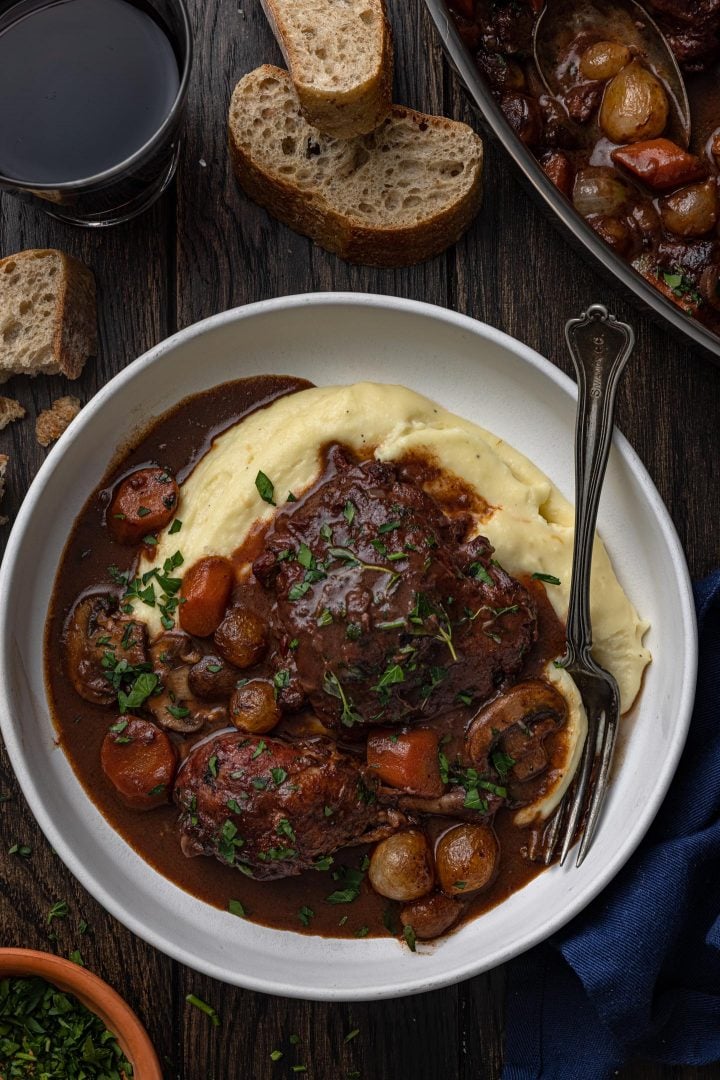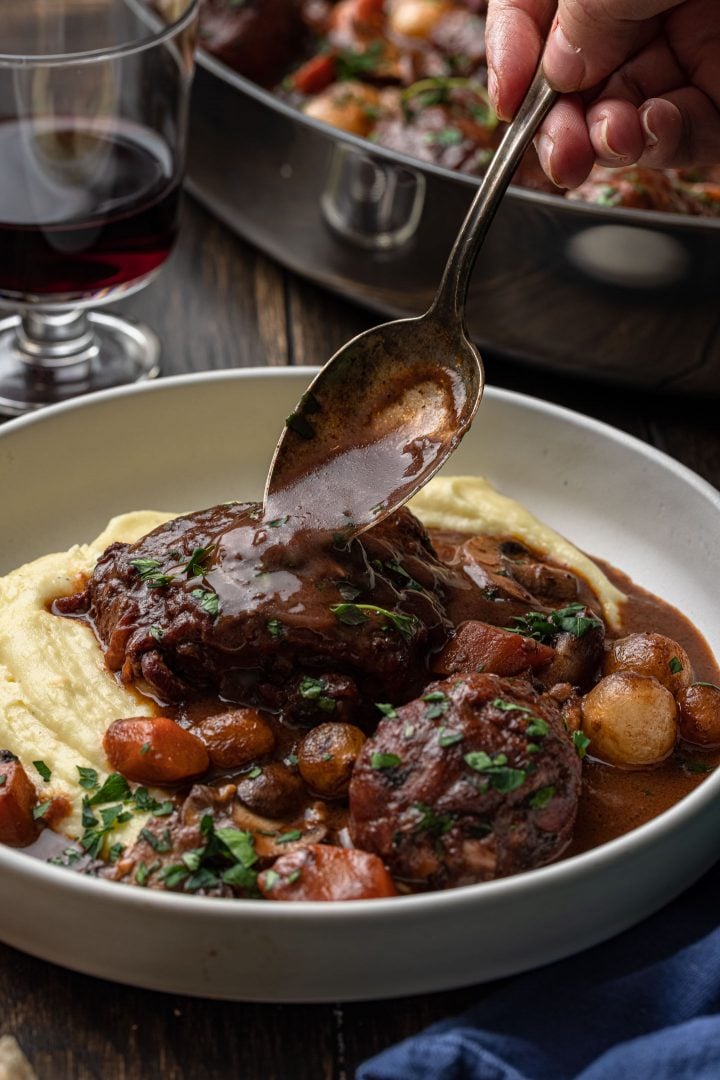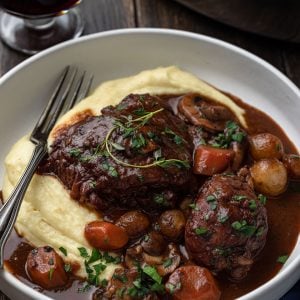The French really know how to do comfort food right! Beef Bourguignon, Coq au Riesling (which is the white wine version of this stew), French Onion Soup, Cassoulet, Potato Dauphinois… Ooh la la! I can’t get enough of French food! Another day, another sexy recipe! ♥️ Because how else would you describe tender pieces of chicken coated in a dark, rich wine sauce? Sexy! That’s the only word to describe this Coq au Vin recipe. This is the type of dish that says “I love you so much that I made you something special”. Except, it is not hard to make. The whole thing can be on the table in about 1.5 hours, but some of that time is hands-off, as the chicken is braised in the oven. Even better, you can make this a day or two ahead and just reheat when ready to serve. Coq au Vin tastes even better the next day, making it the perfect make-ahead meal! What do you think? Ready to make this Coq au Vin the star of your next dinner party or romantic Valentine’s Day dinner? Whichever you choose, I guarantee it will be a hit!
What is Coq au Vin?
Coq au Vin (pronounced Cock-o-van) literally translates to “rooster in wine”. It is a French chicken dish where chicken is braised with wine, lardons and mushrooms. The dish was traditionally made with a rooster (coq), but nowadays everybody uses chicken. In fact, some snobs people claim that what we make today should be called “Poulet au Vin”. A red Burgundy wine is traditionally used, but there are many regional variants throughout France, including Coq au Vin Jaune, Coq au Riesling, Coq au Pourpre, Coq au Violet and Coq au Champagne.
Origins of this Dish
The exact origins of Coq au Vin are not known. Braised chickens and cooking with wine date back to ancient times, so I could bet money that a version of this dish was already being made back then.The fact that this dish was made with rooster implies that it originated as a peasant dish. Rooster meat is quite tough and fibrous, so it takes a long time of marinating and braising to make it tender. I did find a few (unproven) legends that try to pinpoint the origin of coq au vin. The first attributes the creation of the dish to ancient Gaul and Julius Caesar. Back then, the rooster was a symbol of courage and bravery to the Gauls. When besieged by the Romans, the chief of the tribe Arverne sent a rooster to Julius Caesar, to show they would never be defeated. Caesar returned the favor by inviting the chief to dinner, where the rooster was served cooked in wine. A competing theory associates this dish with the French King Henri IV. On a now famous political speech, Henri promised “a chicken in every pot”, meaning general welfare for all, from peasants to the rich. From that promise, grew this dish, even though chances are King Henri wasn’t being literal when he gave that speech! As for the first records of coq au vin, the earliest you will find is a record for a recipe of Poulet au Vin Blanc (chicken in white wine) in an 1864 cookbook called “Cookery for English Households”. Coq au Vin how we know it wasn’t documented until the late 20th century, and the French regions of Burgundy, Champagne, Alsace and Auvergne all claim its origin.However, it wasn’t until Julia Child featured coq au vin in her book called “Mastering the Art of French Cooking“, from 1961, and in her TV show “The French Chef” that the dish gained the popularity it has today.
Ingredients
To make this Coq au Vin recipe, you will need:
Chicken – Coq au Vin is traditionally made with a whole bird, and more modernly with bone-in, skin-on chicken thighs and drumsticks. If you prefer, you can use skinless/boneless thighs, but cooking time will change. Boneless chicken thighs braise faster, about half the time it takes to cook bone-in. But they cost more and don’t pack as much flavor. Also, the marrow in the bones contribute to a richer/thicker stew.Lardon – If you can’t find lardon, you can use slab bacon or – in a pinch – thick cut bacon.Red Wine – Along with the chicken, the red wine is the star of the show here. It’s in the recipe title, after all! So splurge on something good. If you want to go with the classic choice, go with a Burgundian wine. Onions – We’ll use a yellow onion to flavor the sauce and pearl onions to stud the stew at the end. If you don’t want to go through the trouble of peeling pearl onions, you can buy them frozen!Garlic – Because garlic makes everything better!Carrots – Some Coq au Vin recipes don’t call for carrots, including Julia Child’s. I personally like them, so my recipe includes them! That being said, you can leave them out if you prefer.Herbs – Thyme and a bay leaf to flavor the sauce, plus fresh parsley to add freshness at the end.Mushrooms – I like to use cremini mushrooms, sometimes labeled as “baby bella” or “baby portobello”.Oil – For browning the chicken.Butter – We’ll use butter to sauté the pearl onions and mushrooms. You will also need butter if you wish to make a beurre manie (a paste of flour and butter) to thicken the stew.Tomato Paste – A little bit of tomato paste adds a touch of sweetness, which helps to balance the bitterness from the red wine.Flour – To thicken the stew.Chicken Stock – Homemade is best, but if you must go with store-bought, make sure to buy something high-quality!Salt and Pepper
How to Make Coq au Vin
If you’ve never cooked coq au vin before, let me start by saying it is much easier than you imagine. And much quicker than it used to be when people made coq au vin with a real coq (rooster), in a wood-fired oven. Now, you will find a bazillion different recipes for Coq au Vin on Google, all ranging in difficulty, number of cookware necessary to make the recipe and time commitment. I have tried my best to simplify this recipe so it is something anyone can do in any kitchen, with as little resulting dishes to wash as possible. Unlike some recipes, I do not marinate my chicken at all. After trying both ways, I find that it does not make that much of a difference, especially since I am not someone who knows what I’m making for dinner the night before. 😂 I imagine that the marinade really does make a difference if you are cooking a tough old rooster, since acids in the wine help tenderize the meat. We are using chicken here, therefore I really don’t see the need for this extra step. But don’t take my word for it! Try it both ways – marinating with the wine and herbs overnight (or up to 24 hours) and without marinating – to find what you like best. I also really wanted to transform this recipe into an one-pot dish. But I do find that sautéing the pearl onions and mushrooms separately, and adding them at the end, is better. That way they retain their texture and flavor, which otherwise get soggy and toned down from cooking for so long in the sauce. Recommended tools and equipment: 6 to 8-quart Dutch Oven, sauté pan or skillet, tongs, wooden spoon. Here’s how I make this Coq au Vin recipe. As always, you will find the printable (and more complete) version of the recipe at the end of this post!
Step 1: Brown the Chicken
Pat dry the chicken pieces, so it browns nicely. Then, season generously with salt and pepper.Heat the oil and cook the lardons until lightly browned. Remove to a plate.Add the chicken and brown on all sides. Depending on the size of your pot, you might need to work in batches as to not overcrowd the pot. When you overcrowd the pot, you lower the temperature of the oil. The chicken then releases moisture instead of crisping up/browning, which creates steam. Instead of browning, it boils in its own juices, which is not what we are after here!Remove the chicken from the pot and reserve.
Step 2: Make the Stew
If the chicken has rendered too much fat, drain the excess or wipe with a paper towel, being careful not to disturb the browned bits from the bottom of the pot. That’s very flavorful and we don’t want to get rid of it!Sauté the diced onion and carrots until the onions have softened. Add garlic and cook until fragrant.Stir in the tomato paste and a tablespoon of flour.Pour in the bottle of red wine and add the thyme sprigs and bay leaves. You can tie the thyme sprigs with kitchen twine to make it easier to dispose of them later. Scrape the browned bits from the bottom of the pot with a wooden spoon.Cook until the wine reduces by half, skimming off whatever foam that rises to the surface.Pour in the chicken stock and season with a small pinch of salt and pepper. Remember, you can always add more seasoning at the end, but you can’t take it away.Once boiling, return the chicken, lardon and juices to the pot. Cover and transfer to a 350ºF oven to braise for 45 minutes.
Step 3: Assemble the Coq au Vin
When there’s about 15 minutes left for the chicken, start preparing the pearl onions and mushrooms.Heat oil and butter in a large skillet and sauté the pearl onions with a small pinch of salt until browned. Remove and reserve. Then, add more oil and butter and sauté the mushrooms until browned. Season and reserve.Once the chicken is tender, remove it to a serving bowl or deep platter, tenting with foil to keep it warm.Return the pot to the stove and discard the herbs. If desired, thicken the stew with a beurre manié. You can make beurre manié by mixing equal parts of softened butter with flour.Taste and adjust seasoning.Add the browned pearl onions and mushrooms to the sauce. Stir in the parsley, reserving some to garnish the dish.Pour the sauce over the chicken and serve, garnished with the remaining parsley!
Serving Suggestions
Coq au Vin, like any saucy dish, is best served with something starchy, such as roasted or mashed potatoes, rice or even pasta. My favorite side dishes to go with it are Smoked Gouda Mashed Potatoes or Potato Gratin Dauphinois. A nice crusty bread on the side is also a must! As for wine pairing, you can pair it with the wine you used to cook it, preferably a Burgundy or Pinot Noir. Something light to medium bodied with high acidity to cut through the richness of the stew. 🍷
Coq au Vin Variations
I may be biased, but I think my coq au vin recipe is perfect just as it is! That being said, this is one of those dishes that everybody makes a little bit different. So why not make it your own? Here are a few suggestions:
Make it the classic way, by marinating the chicken with red wine and herbs overnight (or for as little as one hour). Try a white wine version, which is then called Coq au Vin Blanc or Poulet au Vin Blanc. Or you can try my recipe for Coq au Riesling!Use skinless chicken thighs instead of the bone-in, skin-on thighs and drumsticks for a quicker, more convenient version. This suggestion is especially for those who are not fans of soggy chicken skin, which is inevitable in coq au vin. I’ve also seen version with chicken breast but have not tried them.Try cooking this recipe in the slow cooker or Instant Pot.Serve garnished with bread croutons, like Melissa Clark does here!
More Stew Recipes
Paprika Chicken Stew with White BeansClassic Beef StewCarbonnade FlamandeGuinness Beef StewFeijoada (Black Bean Stew)Short Rib Stew with YucaPorkolt (Hungarian Beef and Onion Stew)
